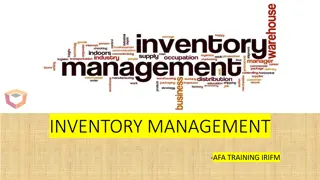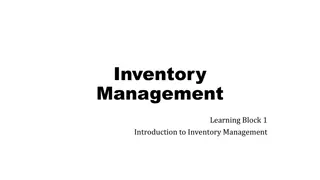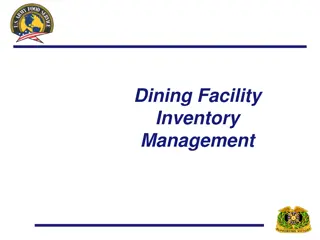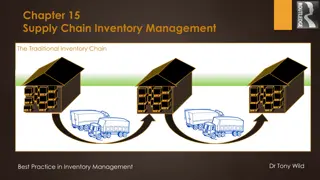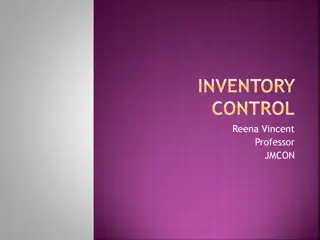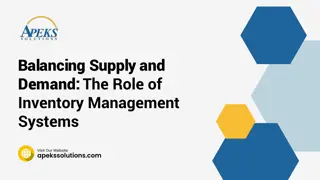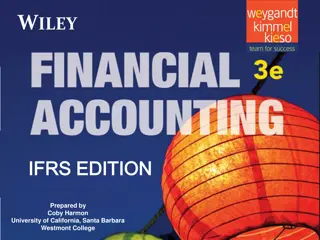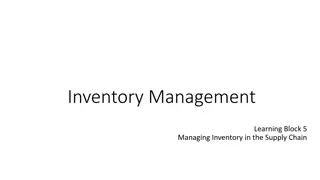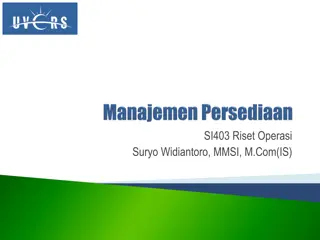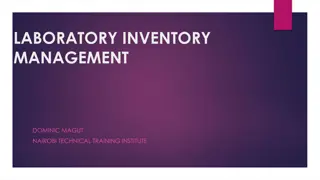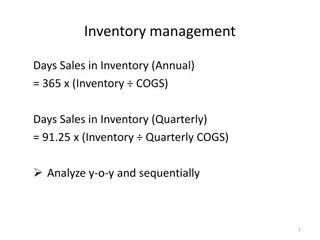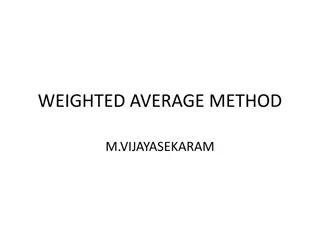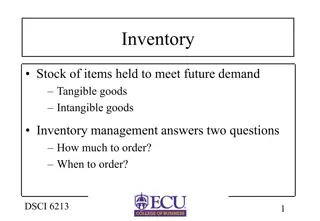Understanding Inventory Management and Control in Business
Inventory refers to the stock of products, raw materials, and goods in various stages of production within a company. Effective inventory management is crucial for ensuring smooth operations, optimizing resources, and meeting customer demands. It involves categorizing inventories, setting objectives for control, and achieving operational and financial goals. Operating objectives focus on material availability, waste reduction, manufacturing efficiency, customer service, production control, and optimal inventory levels. Financial objectives aim at achieving economies in purchasing and maintaining healthy financial practices.
Download Presentation

Please find below an Image/Link to download the presentation.
The content on the website is provided AS IS for your information and personal use only. It may not be sold, licensed, or shared on other websites without obtaining consent from the author. Download presentation by click this link. If you encounter any issues during the download, it is possible that the publisher has removed the file from their server.
E N D
Presentation Transcript
Definition of Inventory 1.Inventories means the stock of the product of a company and components thereof that makes up the product. It includes the raw materials, work in progress and finished goods. 2.It is the physical stock of items a business or production organization kept in hand for the efficient running of business or its production.
Inventories are :- 1. Items in stock. 2. Usable but idle resources. Inventory control Process of maintaining optimum needed quantity of inventories for the smooth operation of organization.
Classification of inventories Rawmaterial inventory Inprocess inventory Inventory Indirect inventory
Objectives of inventory control The basic managerial objectives are 2 fold:- 1. Avoid over/under investment in inventories. 2. To provide right quantity and quality goods at right time at proper value.
Operating objectives Objectives of inventory control Financial objectives
Operating objectives 1. Availability of Materials: All type of material available at all time so that production may not be held up for want of supply of materials. 2. Minimizing the wastage : permit only uncontrollable wastage. Avoid wastage embezzlement, spoilage( rust, dust , dirt) by leakage theft,
3. Promotion of manufacturing efficiency: When right type of raw material is available at the right time. 4. Better service to the customers: Maintain proper production flow to produce sufficient finished goods to meet the demand of of the customers
5. Control of production level: To increase or decrease the production as per the demand as well as to maintain proper buffer stock to meet any eventuality in difficult times. 6. Optimal level of inventories: It is done in view as per the operational requirements.it also avoids the out of stock danger.
Financial objectives 1. Economy in purchasing: management makes every attempt to purchase the raw materials in bulk quantity and to take advantage of favorable market condition. 2. Optimum investment and efficient use of capital: The finance management should set up maximum and minimum levels of stocks to avoid deficiency or surplus of stock position.
3. Reasonable price: Management should ensure supply of raw materials at a reasonable low price without sacrificing the quality of it thereby helping the cost of production and quality of finished goods.
Advantages of inventory 1. Delivery in time: as inventory stored aids smooth production, the manufacturing company can earn reputation as a reliable supply. - our finished goods can be raw materials for buyers. - reputation can get more customers 2. Possibility of discount on bulk purchase 3. Efficiently handle unforeseen circumstances: harthal, bandh or other transportation difficulties do not hinderproduction. 4. No idling of workers and machineries.
Disadvantages of inventory 1. Working capital tied up: cant utilize the amount for other purposes nor it yield any interest. 2. More space required: more inventories more is the space needed and space accounts for rent. 3. Increase insurance charges: Increased cost of handling and manufacturing. 4. Increased over head expenses: Security personnel required to guard inventory. 5. Chances of damage: Pilferage, replacement, etc more. 6. Increased chance of obsolesce.
Inventories constitute a significant part of the working capital. Inventory purchase and production unit) and value (Accounts unit) control used in unit/physical control( control When a firm feel shortage of finance it should take more care in its inventories rather than anything else.
Ordering cost or procurement cost or purchasing cost The cost that has to be spent in making purchase order. Includes all the expenditure associated on placing an order. - postal service expense - expenditure on stationary and consumables. - travelling expense. -time spent by purchase department for order and its equivalence in terms of money. - expenses on supplies. - rent for premises occupied by purchase department - legal fee for lawyers in case such situationsarises.
Inventory carrying cost Cost of blocking material as inventory . This includes:- 1. Cost of interest for the value of items stored as inventory. 2. Salaries of personnel managing including security personnel. 3. Rent for the space occupied by the inventories. 4. The potential scope of loss , pilferage, obsolescence, etc. 5. Cost involved in the insurance of inventories. 6. Stationeries and consumables used by the store people. various position
Under stocking or shortages. It is the cost of not having an item when it is needed, thus affecting the sales of the company. This may lead to 2 situations:- 1. Back logging 2. Cancellation of orders.
Backlogging: work is delayed beyond its schedule and eats away the schedule time of next order thereby delaying the nextorder. Cancellation of order: When buyer is not in a position to wait. Both the above results in: 1. Penality cost: Purchase order will have an in built provision for penality eg, 20% payment reduced for 2 days delay, etc 2. Emergency replenishment: In an urgent situation if you want good quality we may have to spent extra amount eg. Emergency transportation cost,etc. 3. loss of good will
Over stocking cost This results when stock is left on hand when the demand for the item has ended. The left over inventory may be - Utilized at a later stage. - Thrown out as scrap.
1. ABC analysis 2. VED analysis 3. SDE analysis 4. FSN analysis 5. HMLanalysis
ABC analysis Process of classifying items using values as measure. Process of excursing selective control over inventories. Objectives of the analysis 1. Frame policy guidelines regarding control of items. 2. This policy enables material managers to exercise selective control when he is confronted with large number of items. 3. Expensive items are branded as A items(10%) the in between as B(20%) and least expensive as C(70%)
The method. 1. All the item that are used in the industry are identified. 2. Items are listed as per the value. 3. The number of high valued items , medium valued and low valued items are counted. 4. Their percentage is found out. The concept It is practically not feasible to exercise tight control over all items in a large or in medium sized organization. Hence we resort to classify the items according to their importance.
VED analysis Based on the critical values and shortage cost of the item. Thus helps focus on vital items. Based on criticality the item can be classified into 3 categories viz; Vital, Essential and Desirable. Vital items are critically needed in a manufacturing unit. The items with lower criticality included in E and lowest in D. The status of each justification by the material manager in consultation with other departments of the manufacturing unit. item will be discussed with
SDE analysis Classification based on lead time/ availability S( Scarce) those item which are imported or which need a lead time more than 6 months. D(Difficult): The items which require less than 6 months but more than a fort night. E( easily available): Items which are available easily in less than a fort night. Helps bring down lead time and out of stock cost.
FSN analysis Classification based on frequency of issue or use. F = Fast moving items that are frequently issued in a manufacturing unit. S = Slow moving items in a manufacturing unit. N = Non moving item This classification helps in establishing most suitable layout by locating all fast moving items near the dispensing window to reduce the handling efforts.
HML analysis Classification based on unit value. H = high cost M= medium cost L= Low cost This type of analysis helps in exercising control at the use point . Proper authorization should be there for replacing a high value item
Definition of EOQ It is the particular quantity at which the sum of cost of both the ordering and inventory carrying cost is minimum. Total cost = carrying cost + procurement cost
Consumption rate It is the rate at which the raw materials are consumed. If we plot a graph between time and level of inventory the slope of the graph gives the consumption rate Constant consumption rate. If the raw material is consumed at same rate over the same period of time. Actual / irregular consumption rate There will be variation in the production which leads to different consumption rates at different time intervals. Also influenced by factors like power failure.
Replenishment. The process of refilling the material as and when it is consumed so that the inventory level is maintained within a range . Types:- 1. Instantaneous replenishment 2. Replenishment at constant rate 3. Replenishment at irregular rate.
1. Instantaneous replenishment: refilling is done at one time, at one instant for the one full lot size. 2. Replenishment at constant rate: If we replenish the used inventory at a constant rate . Usually practiced in industries especially the ones which manufacture its own raw material. 3. Replacement at irregular interval: The inventory is not refilled at regular interval of time.
Lead time Lead time is the time gap between starting or initiating the process of ordering and receiving the ordered quantity in stores. This is estimated by the past experience. Lead time includes the following:- 1. Time taken to prepare purchase requisition and placing the order. 2. Time taken to deliver purchase order to vendor. 3. Time taken for the vendor to manufacture. 4. Time taken for transportation from vendors place to the stores.
Reorder point This is the point which indicate that it is high time we place the order failing which the stokes may get exhausted. Reorder point = lead time predicted point of exhaustion. Eg. If we order once in every 10 days and the lead time is 3 days then ROP = 10 3 = 7 days.
Lead time analysis. Lead time depends on :- 1. The urgency or importance of the components in the manufacturing process. 2. Reliability of the vendors.
Reserve stock(O-RS)/ Safety stock/Buffer stock To guard against disturbances of production process either due to uncertainties in consumption rates or lead time some extra stock is maintained. It serve the purpose of minimizing the chances of running out of stock. It should not be very less or excess.
Safety stock come to play when there is :- production 1. An excess rejection or wastage in process than normal. 2. Rejection at the time of receipt due to -Poor production quality by vendor. - Damage to raw material.
Factor of uncertainty Uncertainty is the main reason for having safety stock. It may be due to:- 1. Uncertainty of demand 2. Uncertainty of delivery. 3. Uncertainty of quantity.
Uncertainty of demand: there will be a difference between the expected demand and the actual demand which is known as the forecast error. It is mainly dependent on the buyers side. Uncertainty of delivery: depends on how long the lead time is going to be. If something goes wrong with the suppliers production the lead time may prolong. Uncertainty of quantity: this depends on how many scrap or imperfect items the ordered quantity is going to contain.
Determination of safety stock The level of safety stock to be maintained depends on various factors like:- -Cost of item in question -Uncertainties in demand -Negative fall out of stock of this item -Spoilage due to long storage , etc Optimum safety stock = maximum lead time in amount- normal lead time in amount.
Max. lead occurred. purchase department or past records. time = the worst possible scenario Found out in consultation with the Normal lead time = most expected lead time or the average lead time. e.g.. If the maximum lead time is 13 days and the average lead time is 11.5 days then 13-11.5= 1.5, a stock that last for 1.5 days is the optimum safety stock.
Disposal of obsolete and surplus material. Obsolete material: Those materials or equipments which are not damaged and which have economic work but are no longer useful for the company s operation due to change in production line. The term can be associated with equipments, materials, stocks, techniques, etc. It is very difficult to predict when the technology will change leading to obsolescence. The company should have sharp eye on the competition so that it can have more
Causes for Obsolescence 1. Adoption of standardization: lead to elimination of non standard varieties. 2. Adoption of new technology. 3. Changes in production design 4. Cannibalization: when a machine breaks down, it is, sometimes rectified by using components of an identical machine which is already not functional. 5. Faulty purchases : it the purchases are made in bulk so that they can last for a very long time. Can be controlled by FSN analysis
Surplus material Equipments which have no immediate use but had accumulated due to faulty planning , forecasting and purchasing. They have usage value in future. They are merely excess of what is in need. Easy to control compared to obsolete. are in good Both surplus and obsolete materials condition.
Common causes for surplus and obsolete materials 1. Over ordering 2. Faulty planning, purchasing and forecasting. 3. Reduced production. 4. Drastic reduction in wastage. 5. Modification of processes. 6. Faults in store keeping and record keeping.
They need to be disposed ? 1. Keeping them is a costly affair. 2. They need space. 3. More security personnel 4. Separate store for maintaining them. 5. More chances of pilferage, damage etc.
Stages of disposal of obsolete and surplus. 1. Finding: Periodic study must be carried out of all items stocked or staying as inventory. 2. Recrimination: Alternative ways of using these items must be explored within the industry. 3. If they cannot be used any where then disposal act is carried out.
Priorities in the process of disposal. 1. Explore possibility of sending in bulk. 2. Dispose to original supplier if they show interest. 3. Preference may be given to buyers or vendors who have long term relation with the company. 4. Then think of others who may buy at best possible price. 5. If it cannot be pushed off at best possible price, sell at scrap value. 6. If it is not possible dispose them off free of cost to someone who can use them. ( sometimes when distribute to employers it may lead to a negative side effect ethical issue, purposeful
Process of disposal of obsolete and surplus material. By negotiation by which buyers approaches for the purchase of such materials. Auction. Tenders.
Material handling Moving physical objects from one place to another as parts, components, sub assemblies, raw materials, or finished goods ready for shipment. Defined as the function dealing with the preparation, placing and positioning of materials to facilitate their movement or storage. The moving of materials from raw material store to through production to ultimate consumer with least expenditure of time, effort so as to produce maximum productive efficiency and lowest handling cost









